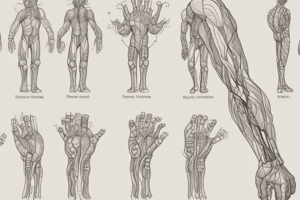Podcast
Questions and Answers
What is the shape of the cubital fossa?
What is the shape of the cubital fossa?
- Circular
- Square
- Triangular (correct)
- Rectangular
Which muscle bounds the cubital fossa laterally?
Which muscle bounds the cubital fossa laterally?
- Triceps brachii
- Biceps brachii
- Pronator teres
- Brachioradialis (correct)
Which nerve runs through the cubital fossa?
Which nerve runs through the cubital fossa?
- Ulnar nerve
- Radial nerve
- Median nerve (correct)
- Axillary nerve
What is contained within the cubital fossa?
What is contained within the cubital fossa?
What composes the floor of the cubital fossa?
What composes the floor of the cubital fossa?
Why is the cubital fossa significant in clinical practice?
Why is the cubital fossa significant in clinical practice?
Which of the following statements about the ulnar nerve is correct?
Which of the following statements about the ulnar nerve is correct?
What structure forms the roof of the cubital fossa?
What structure forms the roof of the cubital fossa?
Flashcards
Cubital fossa location
Cubital fossa location
A triangular depression anterior to the elbow joint.
Cubital fossa boundaries
Cubital fossa boundaries
Bounded laterally by brachioradialis, medially by pronator teres.
Cubital fossa floor
Cubital fossa floor
Formed by brachialis, supinator, and deep brachial artery.
Cubital fossa roof
Cubital fossa roof
Signup and view all the flashcards
Cubital fossa contents
Cubital fossa contents
Signup and view all the flashcards
Brachial artery location
Brachial artery location
Signup and view all the flashcards
Venipuncture site
Venipuncture site
Signup and view all the flashcards
Neurovascular assessment area
Neurovascular assessment area
Signup and view all the flashcards
Study Notes
Anatomical Location
- The cubital fossa is a triangular-shaped depression anterior to the elbow joint.
- It's bounded laterally by the brachioradialis muscle and medially by the pronator teres muscle.
- The floor is formed by the brachialis, supinator, and the deep brachial artery.
- The roof or apex is formed by the skin and superficial fascia.
- The apex of the cubital fossa points towards the lateral epicondyle of the humerus.
Contents of the Cubital Fossa
-
The cubital fossa contains important neurovascular structures crucial for the upper limb.
-
Nerves:
- Median nerve runs through the fossa.
- Radial nerve (part of it) lies within the lateral side of the fossa in some cases, if a communicating branch is present.
- Ulnar nerve is located outside the cubital fossa.
-
Arteries:
- Brachial artery is the primary artery of the arm, traveling through the fossa.
- It divides into the radial and ulnar arteries distally in the forearm.
- Several branches can accompany this artery, including the superior ulnar collateral artery and the inferior ulnar collateral artery.
-
Veins:
- The brachial vein accompanies the brachial artery, and these merge into the axillary vein proximally.
- Several veins draining the muscles and skin of the forearm merge around the brachial vein.
Clinical Significance
- The cubital fossa is a common site for venipuncture due to the superficial location of veins.
- It's a critical area for evaluating the neurovascular status of the upper limb.
- Palpating the brachial artery can provide information about the peripheral circulation status.
- The cubital fossa allows for access to the proximal upper limb vessels and nerves.
- Understanding the anatomy of the cubital fossa is vital for medical professionals performing procedures like injections, blood draws, and surgical interventions.
- A hematoma (blood collection) can form at the puncture site if the procedure is improper.
- The location of the cubital fossa is relevant during emergency care, where fast access to the brachial artery is critical.
- Neurological testing of the arm's nerve function can be assessed at this location.
- Direct trauma or injury to the structures in the cubital fossa can potentially damage these critical nerves and arteries.
Important Relationships
- The cubital fossa's structures' relationships to surrounding structures must be understood to avoid injury.
- Understanding the boundaries, floor, and roof of the fossa is crucial.
- The location and movement of various muscles in the area need careful annotation and consideration.
- The position of the elbow joint, in relation to the cubital fossa, is also significant information.
Studying That Suits You
Use AI to generate personalized quizzes and flashcards to suit your learning preferences.




